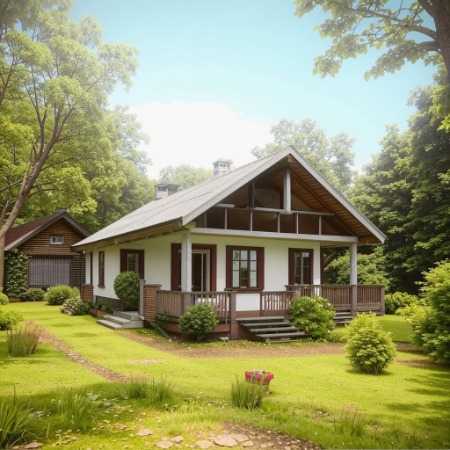Roof insulation is one of the most critical tasks during building construction and renovation, directly impacting energy efficiency, comfort, and the durability of a home. A properly selected and correctly installed insulation system significantly reduces heat loss, protects the structure from moisture and condensation, and improves the indoor microclimate. In this article, we will explore the main types of roof insulation systems, their features, advantages and disadvantages, as well as key installation aspects and material selection.
The Importance of Roof Insulation Systems in Modern Construction
Modern energy efficiency and environmental standards impose strict requirements on building thermal insulation. The roof, being one of the most vulnerable parts of a house through which a significant portion of heat escapes, demands special attention. Roof insulation systems create a multi-layer “sandwich” that not only retains heat but also protects against moisture and wind exposure.
Moreover, a well-designed insulation system helps prevent mold and mildew formation caused by moisture condensation inside the structure. This is especially important for wooden houses and attic spaces where humidity can significantly affect residents’ health and building materials.
Overall, roof insulation systems are not just about laying insulation but represent a comprehensive approach that includes vapor barriers, waterproofing, and ventilation of the roof space.
Types of Roof Insulation Systems
There are several main types of roof insulation systems used depending on roof structure, climatic conditions, and energy efficiency requirements. The classic system involves laying insulation material between rafters with mandatory vapor barrier installation on the interior side and waterproofing on the exterior.
Another popular method is installing insulation over the rafter system. This technology helps eliminate thermal bridges and increase the structure’s airtightness. Proper installation of waterproofing and ventilation gaps is crucial in this case.
For flat roofs, insulation systems with insulation placed below or above the waterproofing layer are applied depending on roofing type and operational conditions. Combined systems that incorporate several insulation methods for maximum efficiency also exist.
Key Components of Roof Insulation Systems
Every roof insulation system includes several essential layers. The first is the thermal insulation material, which must have low thermal conductivity, high moisture resistance, and durability. The most common materials are mineral wool, basalt wool, polystyrene foam, and extruded polystyrene foam.
The second critical element is the vapor barrier, which prevents water vapor from inside the building from penetrating the insulation. Without a quality vapor barrier, insulation will eventually become wet and lose its thermal properties.
Waterproofing protects the insulation and roof structure from atmospheric precipitation and condensation forming under the roofing. Additionally, to avoid moisture accumulation, a ventilation gap is required to ensure air circulation and moisture removal.
Installation Technology of Roof Insulation Systems
Installation begins with surface preparation — cleaning and inspecting the rafter system for damage. Then, vapor barrier film is installed on the interior side, which must be securely fixed and sealed at joints.
Next, the insulation material is installed. When insulating between rafters, it is important to ensure tight fitting without gaps. When installing insulation over rafters, boards are laid with minimal joints and fixed with special fasteners.
The next step is waterproofing installation on the outer side of the insulation. It is important to follow installation technology considering roof slope direction to prevent water ingress under the roofing. The system is completed by creating a ventilation gap, which can be provided by counter-batten or special aerators.
Advantages and Disadvantages of Various Insulation Systems
The classic insulation system between rafters is the most common and economical. It preserves interior space and provides adequate thermal insulation. However, improper installation can cause thermal bridges and ventilation problems.
Insulating over rafters provides higher thermal insulation and eliminates thermal bridges but requires more complex structural solutions and increases load on rafters. This system is suitable for new buildings and major renovations.
Flat roofs insulated beneath waterproofing are convenient for creating usable roofs or terraces but require careful waterproofing and ventilation control. Combined systems allow for the most effective use of materials and technologies but demand professional design and installation.
Comparative Table of Popular Roof Insulation Systems
| Insulation System | Advantages | Disadvantages | Recommended Materials |
|---|---|---|---|
| Between Rafters | Economical, easy installation | Thermal bridges, insulation thickness limits | Mineral wool, basalt wool |
| Over Rafters | High insulation, no thermal bridges | Increased load, complex installation | Polystyrene foam, extruded EPS |
| Flat Roof | Enables usable roof space | Requires strict waterproofing and ventilation | Polystyrene foam, extruded EPS |
| Combined Systems | Maximum insulation efficiency | High cost and installation complexity | Material combinations |
Conclusions and Recommendations for Choosing Roof Insulation Systems
The choice of roof insulation system depends on many factors: roof type, climate, budget, and building usage goals. For private houses with traditional pitched roofs, the classic system with insulation between rafters is often optimal. It balances affordability and effectiveness.
If maximum insulation and elimination of thermal bridges are required, consider insulation over rafters. For flat roofs, special attention to waterproofing and ventilation is essential to avoid moisture problems.
Regardless of the system chosen, quality installation and adherence to all technical requirements remain key. This guarantees durability, comfortable indoor climate, and energy savings.

